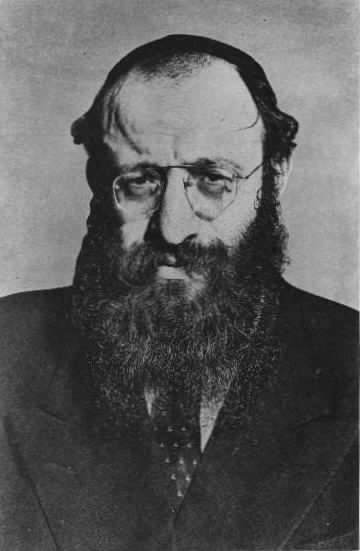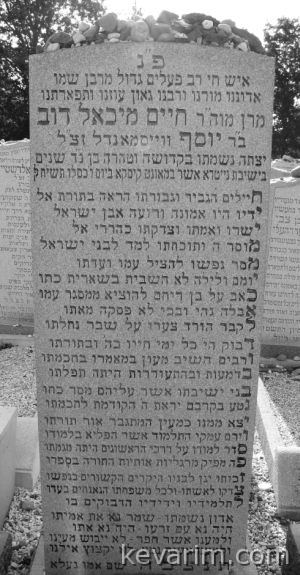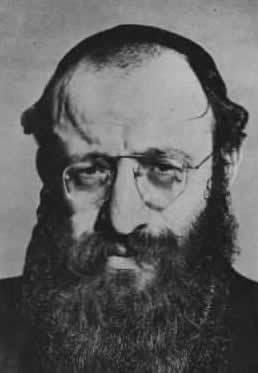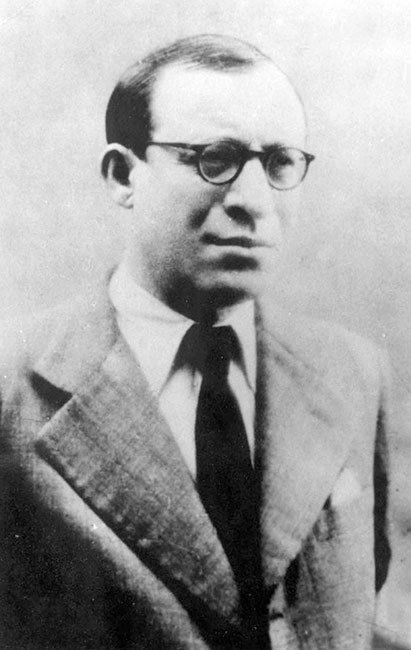Began 1946 Role Rabbi Ended 29 November 1957 Positions Rosh yeshiva | Denomination Orthodox Yeshiva Yeshiva of Nitra Name Chaim Dov | |
 | ||
Birth name Chaim Michael Dov Weissmandl Born 25 October 1903
Debrecen, Hungary ( 1903-10-25 ) Parents Yosef and Gella Weissmandl Died November 1957, Mount Kisco, New York, United States | ||
Chaim Michael Dov Weissmandl (Hebrew: חיים מיכאל דב וויסמנדל) (25 October 1903, Debrecen, Hungary – 29 November 1957, Mount Kisco, New York) (known as Michael Ber Weissmandl) was a rabbi and shtadlan who became known for his efforts to save the Jews of Slovakia from extermination at the hands of the Nazis during the Holocaust. Thanks to the efforts of his "Working Group", which bribed German and Slovak officials, the mass deportation of Slovak Jews was delayed for two years, from 1942 to 1944.
Contents
- Early life
- World War II and the Holocaust
- The Working Group
- Deportation
- Personal recovery
- An innovative American yeshiva
- Later life
- Statements
- Books
- References

Largely by bribing diplomats, Weissmandl was able to smuggle letters or telegrams to people he hoped would help save the Jews of Europe, alerting them to the progressive Nazi destruction of European Jewry. It is known that he managed to send letters to Winston Churchill and Franklin D. Roosevelt, and he entrusted a diplomat to deliver a letter to the Vatican for Pope Pius XII.

He also begged the Allies to bomb the rails leading to Auschwitz, but to no avail. He believed that if the Hungarian Jews would resist, then only a small number of them would be deported, as the Germans in 1944 could not garner enough soldiers to leave the front and deal with the Jews simultaneously. Of around 900,000 Hungarian-speaking Jews, close to 600,000 were murdered.

Early life

Michael Ber was born in Debrecen, Hungary on 25 October 1903 (4 Cheshvan 5664 on the Hebrew calendar) to Yosef Weissmandl, a shochet. A few years later his family moved to Tyrnau (now Trnava, Slovakia). In 1931 he moved to Nitra to study under Rabbi Shmuel Dovid Ungar, whose daughter, Bracha Rachel, he married in 1937. He was thus an oberlander (from the central highlands of Europe), a non-Hasidic Jew.
Weissmandl was a scholar and an expert at deciphering ancient manuscripts. In order to carry out his research of these manuscripts, he traveled to the Bodleian Library in Oxford, England. It is related that he was treated with great respect by the Chief Librarian of the Bodleian after an episode when he correctly identified the author of a manuscript which had been misattributed by the library’s scholars.
World War II and the Holocaust
While at Oxford University, Weissmandl volunteered on 1 September 1939 to return to Slovakia as an agent of World Agudath Israel. Later he was the first to demand that the Allies bomb Auschwitz. When the Nazis gathered sixty rabbis from Burgenland and sent them to Czechoslovakia, Czechoslovakia refused them entry and Austria would not take them back. Rabbi Weissmandl flew to England, where he was received by the Archbishop of Canterbury and the Foreign Office. Explaining the tragic situation, he succeeded in obtaining entry visas to England for the sixty rabbis.
The Working Group
When the Nazis, aided by members of the puppet Slovak government, began its moves against the Slovak Jews in 1942, members of the Slovak Judenrat formed an underground organization called the Working Group. It was led by Gisi Fleischmann and Rabbi Weissmandl. The group's main activity was to help Jews as much as possible, in part through payment of large bribes to German and Slovak officials. At Rabbi Weissmandl's initiative already in 1942 the Working Group initiated high-level ransom negotiations with the Germans (ref. Fuchs and Kranzler books). The transportation of Slovak Jews was in fact halted for a long time after they arranged a $50,000 (in 1952 dollars) ransom deal with the Nazi SS official Dieter Wisliceny.
Some historians, for example Dr. Abraham Fuchs and Prof. David Kranzler, accept Weissmandl's opinion that the ransom and bribes were successful. Israeli historian Prof. Yehuda Bauer wrote in 1981 book that he thought the bribes influenced Germany's position regarding deportation, but in a 1996 book he expressed skepticism about whether the bribes were a key factor in stopping the deportations. However, later in a 2002 book Bauer writes that it was not the bribing of Wisliceny that stopped the deportations, but the bribing of the Slovak officials by the Working Group that stopped it.
At Rabbi Weissmandl's initiative, the Working Group was also responsible for the ambitious but ill-fated Europa Plan which would have seen large numbers of European Jews rescued from their Nazi captors. An agreement was negotiated with the Nazis in late 1942 and one to two million dollars ransom was required to stop most transports. The Germans asked for a 10% down payment. Unfortunately the down payment was never made. Nothing came of it. Sally Mayer, the JOINT representative in Switzerland, was unwilling to provide the down-payment since currency transfer to Nazis was illegal. Another opinion is that Heinrich Himmler intervened in August 1943. Also the Jewish Agency, contrary to Nazi stereotypes of Jewish wealth, had an available budget of $160K US/month (40K Pounds) for rescue efforts and simply did not have the money. Friling gives the amount demanded for temporarily halting the transport as $3 million USD.
The Working Group also played a central role in distribution of the "Auschwitz Report" in spring 1944, which ultimately led to its publication in Switzerland by George Mantello. That triggered a major Swiss grass roots protest in the Swiss press, churches and streets. It was a major factor in President Roosevelt, Winston Churchill and others threatening Hungary's Fascist regent Horthy with post-war retribution if he did not immediately stop the transports. At the time 12,000 Jews a day were transported to Auschwitz. Among others rescued as a result of the Working Group's activities were Rebbe Aharon Rokeach of Belz, and Rabbi Yoel Teitelbaum of Satmar.
Since the business of the Working Group required a continuous supply of large sums of money, they turned to the international Jewish organizations for help, via their representatives in Switzerland. Weissmandl claimed that too little money was provided too late and that this was due to the indifference of those he asked. Specifically, he accused the Zionist organizations of refusing to assist in saving Jews unless they were to go to Palestine. Weissmandl supported his allegations by quoting letters from memory, and some historians such as Bauer had doubt in the accuracy of his account. Other historians, such as Fuchs and Kranzler, accepted Rabbi Weissmandl's word. Friling however points out various statement by members of the Zionist leadership to the contrary, asking that any and all doors be opened for the rescue of Jews. For example, they pleaded that Polish children sent to South Africa, why not Jewish children - South African Prime Minister Jan Smuts refused. Allies ferried Italians from Ethiopia to Italy, why not Jews on the return? Similarly ships carrying armaments to Allied troops in North Africa returned empty to America. Their pleas were ignored.
Deportation
In 1944, Weissmandl and his family were rounded up and put on a train headed for Auschwitz. Rabbi Weissmandl escaped from the sealed train by sawing open the lock of the carriage with an emery wire he had secreted in a loaf of bread. He jumped from the moving train, breaking his leg in the process, and hid in a secret bunker in suburban Bratislava.
Rudolf Kasztner and his Nazi associate Kurt Becher took Weissmandl from his Bratislava bunker to Switzerland. This was highly unusual for both Kasztner and Becher. There is some speculation that Kasztner and Becher sought to reinforce their alibis for the predictable post-war trials. There is debate whether there was a reason for Kasztner to imagine that he would be put on trial as a Nazi-collaborator. See the film Killing Kasztner for details of his trial and subsequent murder and a reversal of the verdict. Today Kasztner is controversially recognized for saving the lives of thousands of Jews at Yad Vashem.
Personal recovery
After the war, Weissmandl arrived in the United States having lost his family and having been unable to save Slovak Jewry. At first he was so distraught that he would pound the walls and cry bitterly on what had befallen his people. Later he remarried and had children, but he never forgot his family in Europe and suffered from depression his entire life because of the Holocaust.
His second marriage was to Leah Teitelbaum (1924/5–9 April 2009), a daughter of Rabbi Chaim Eliyahu Teitelbaum and a native of Beregszász, Hungary. With his second wife, Weissmandl had five children.
An innovative American yeshiva
In November 1946, Weissmandl and his brother-in-law, Rabbi Sholom Moshe Ungar, re-established the Nitra Yeshiva in Somerville, New Jersey, gathering surviving students from the original Nitra Yeshiva. With the help of Rabbi Shraga Feivel Mendlowitz, Rabbi Weissmandl bought the Brewster estate in Mount Kisco, in Westchester County, New York and moved his Yeshiva there in 1949. There he established a self-sustaining agricultural community known as the "Yeshiva Farm Settlement". At first this settlement wasn't welcome by its neighbors, but in a town hall meeting, Helen Bruce Baldwin (1907–1994) of nearby Chappaqua, wife of New York Times military correspondent and Pulitzer Prize winner, Hanson W. Baldwin, impressed by Rabbi Weissmandl, defended its establishment and wrote a letter-to-the-editor to the New York Times regarding it. Weissmandl designed the community's yeshiva to conform with Talmudic accounts of agricultural settlements, where a man would study Torah continuously until an age suitable for marriage, whereupon he would farm during the day and study in the evenings. While this novel approach was not fully realized, the yeshiva flourished. Currently, the settlement is known as the Nitra community.
Later life
During his later years, Weissmandl suffered from chronic heart disease and was frequently hospitalized. He suffered a severe heart attack in the early winter of 1957 and was hospitalized for several weeks. Upon his release, he attended the yeshiva's fundraising banquet, and then was readmitted to the hospital. His health deteriorated and he died on Friday, 29 November 1957 (6 Kislev 5718) at the age of 54. His second wife never remarried.
Statements
In a letter, dated May 15, 1944, addressed to the Zionist leadership in Palestine (under British rule) Rabbi Weissmandl called on the Zionist leadership to take stronger action on behalf of European Jewry which was systematically being destroyed by the Nazi lead genocide:
And you - our brothers in Palestine, in all the countries of freedom, and you, ministers of all the kingdom — how do you keep silent in the face of this great murder ? Silent while thousand on thousands, reaching now to six million Jews, were murdered. And silent now while tens of thousands are still being murdered and waiting to be murdered? Their destroyed hearts cry to you for help as they bewail your cruelty. Brutal you are and murderers too you are, because of the cold-bloodedness of the silence in which you watch.
Books
Two of Weissmandl's books were published posthumously.
In 1958, Rabbi Weissmandl republished the magnum opus of Rabbi Jonah Teomim-Frankel, Kikayon D'Yonah with his own footnotes and glosses. In the introduction to this volume, Rabbi Weissmandl gives an emotional history lesson.
